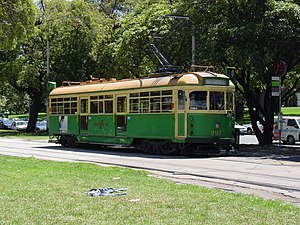W-class Melbourne tram
| W-class | |
|---|---|

W6 992 in Victoria Street
|
|
| Manufacturer | Melbourne and Metropolitan Tramways Board |
| Assembly | Holden Body Builders Holden Street Workshops James Moore & Sons Preston Workshops |
| Constructed | 1923–1956 |
| Number in service | 12 in Melbourne (all on City Circle) |
| Fleet numbers | 219–1040 (Not all numbers in that range are used by W classes) |
| Depot(s) | Southbank |
| Specifications | |
| Electric system(s) | 600 V DC, Catenary |
| Current collection method | Trolley pole or pantograph |
| Track gauge | 1,435 mm (4 ft 8 1⁄2 in) standard gauge |
W-class trams are family of electric trams built by the Melbourne and Metropolitan Tramways Board between 1923 and 1956. Over the 33 years of production, 752 vehicles spanning 12 sub-classes were constructed, the majority at the MMTB's Preston Workshops.
A small fleet continue to operate on the tramway network of Melbourne, Australia, where they are used on the City Circle tourist route and the Colonial Tramcar Restaurant service. The W-class tram is a cultural icon to Melbourne, those that remain in Melbourne are classified by the National Trust of Australia.
As well as Melbourne, W-class trams operate on tourist and heritage systems across the world. A number of older variants have been withdrawn from service and later sent to cities such as Copenhagen, Savannah and Seattle, and private enthusiasts.
W-class trams were introduced to Melbourne in 1923 as a new standard design. They had a dual bogie layout and were characterised by a substantial timber frame supplanted by a steel under frame, a simple rugged design, and fine craftsmanship (particularly the older models). The W class was the mainstay of Melbourne's tramways system for 60 years. A total of 752 trams of all variants were built.
The W2 variant was supplemented in the late 1930s by 120 W5 (or "Clyde") class trams with wider cabins, and more powerful motors, however these were notorious for being difficult to drive smoothly. The W6 followed on, and became the most popular W-class tram with crews and passengers alike as they were fast, smooth and comfortable, compared with earlier W variants. Construction came to a halt for some years, with the final 40 W-class trams emerging from the Preston Workshops in 1956, when the need to provide something more capable of dealing with Olympic Games crowds than Bourke Street's buses prompted the last expansion of the network.
...
Wikipedia
